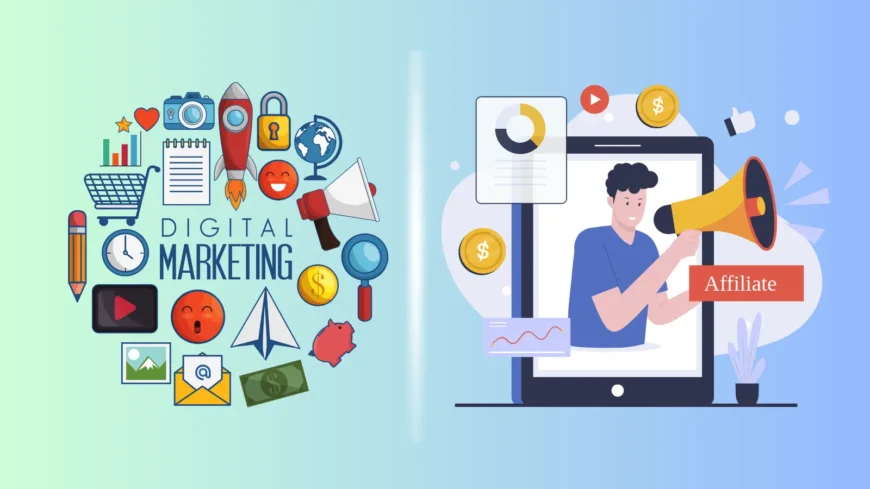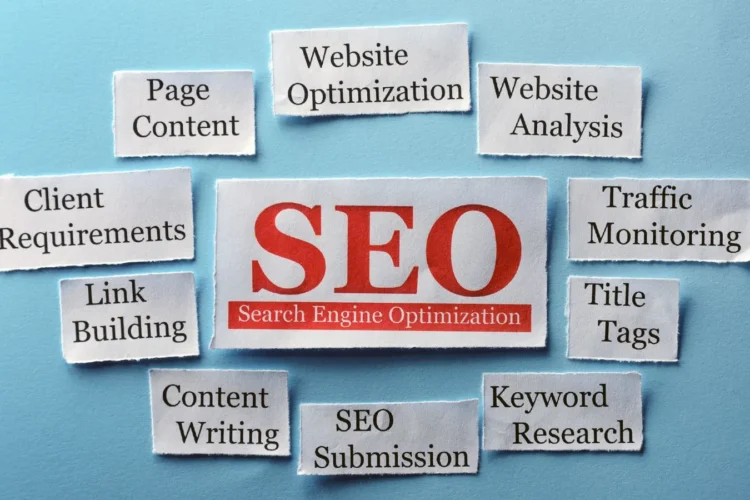
Can’t decide between digital marketing and affiliate marketing? Your search ends here. These terms sound similar but represent two very different business models. As an online entrepreneur, it’s important to understand the key differences to determine the best path for you.
Let’s break down what digital marketing and affiliate marketing are, how they work, and their pros and cons, and explore the key differences, like how they generate revenue, the amount of control and work required, and potential returns. By the end, you’ll have a clear sense of which model aligns most with your goals and strengths. The choice is yours – let’s dive in!
Defining Digital Marketing
Digital marketing uses electronic media to promote your business and reach new audiences. This includes things like:
- Social media marketing on platforms like Facebook, Instagram, and Twitter
- Content creation through blogging, videos, and email newsletters
- Search engine optimization to rank higher in search results
- Pay-per-click advertising like Google Ads to drive traffic to your site
Digital marketing aims to increase brand awareness, connect with your target audience, drive traffic to your website, and ultimately generate more sales or conversions. Unlike traditional marketing, digital marketing allows you to track metrics and analytics to see what’s working and make changes to improve your results.
Affiliate marketing, on the other hand, is a performance-based marketing model where you earn a commission for promoting someone else’s product or service. You sign up with a merchant like Amazon or eBay and get paid when you refer customers who buy something.
While digital marketing and affiliate marketing share some similarities, some key differences must be understood if you want to leverage them for your business. The choice between them comes down to your business goals, resources, and how much control you want over your marketing campaigns.
Understanding Affiliate Marketing
Affiliate marketing is about promoting other companies’ products and earning a commission for any sales you drive. As an affiliate, you’ll sign up with affiliate networks like CJ Affiliate or ShareASale and search their merchant listings for products you want to promote.
Once you find products that match your audience, you’ll get a unique affiliate link to share on your website, email newsletter, or social media. Any time someone clicks your link and buys that product, you’ll earn a percentage of the sale as a commission.
Types of Affiliate Programs
There are a few popular types of affiliate programs:
- Pay per sale: When someone buys a product using your link, you get paid. This is the most common type.
- Pay per lead: You get paid when someone submits their contact info, which is often used for services like insurance quotes or loan applications.
- Pay per click: You get paid just for people clicking your affiliate link. It’s not as standard, but it can still be lucrative.
The key to success with affiliate marketing is promoting the right products to the right audience. Do some research to find products that genuinely help your readers. And be transparent that the links are affiliate links – that will build trust with your audience so they use them! With time and testing, you’ll find the best products better and earn more commissions.
Key Differences Between Digital Marketing and Affiliate Marketing
The key differences between digital marketing and affiliate marketing are:
Business Model
Digital marketing focuses on promoting a company’s products or services. Affiliate marketing promotes other companies’ products or services in exchange for a commission. Affiliates act as independent marketers for other brands.
Risk and Reward
With digital marketing, the business assumes all the risks but keeps all the rewards. Affiliate marketing has little risk for affiliates but typically offers a smaller commission reward, usually between 5-30% of sales. The business only pays affiliates when their marketing efforts drive sales.
Content Creation
Digital marketers create content to build their brand. Affiliates curate content that promotes a brand’s products to their audience. The business may provide some resources, but affiliates are primarily responsible for content creation and distribution.
Audience Targeting
Digital marketing aims to reach a broad audience, build brand awareness, and drive sales. Affiliate marketing relies on affiliates to leverage their unique audiences and niche websites. Affiliates have an incentive to target high-intent audiences that will convert.
In summary, while digital marketing and affiliate marketing share similar goals, there are distinct differences in their business models, risks and rewards, content creation, and audience targeting. Both play an essential role in an effective online marketing strategy.
When to Use Digital Marketing vs Affiliate Marketing
Digital marketing and affiliate marketing are two popular ways to promote a business online, but they have some key differences. Digital marketing is best when you want to promote your products or services directly on your online channels. Things like:
- Creating social media profiles for your business
- Posting updates, photos, and videos to raise brand awareness
- Starting an email newsletter to stay in touch with customers
- Optimizing your website to rank higher in search engines
Affiliate marketing involves partnering with independent publishers who promote your products to their audiences. It’s ideal when:
- You want to reach new potential customers through other websites and social media platforms.
- Your marketing budget is limited. Affiliates are paid on commission, so it’s a low-cost way to expand your reach.
- You have an established product line and a loyal customer base. Affiliates will have an easier time promoting your products if you already have happy customers and reviews.
For the best results, consider combining both digital marketing and affiliate marketing. Build your audiences through social media and content creation, but also tap into affiliates to gain exposure to their established followings. A balanced approach will help maximize your online visibility and sales.
Combining Digital Marketing and Affiliate Marketing for Success
Combining digital and affiliate marketing is a smart strategy to increase traffic, build brand awareness, and boost revenue.
Synergistic Success
Digital marketing brings people to your website or social media through paid ads, SEO, content creation, and engagement. Affiliate marketing then converts some of that traffic into sales by offering commissions to influencers who promote your products to their followers.
Working together, these approaches are greater than the sum of their parts. Digital marketing casts a wide net to catch potential customers’ interest. Affiliate marketing then reels them through trusted recommendations from influencers they already follow. The result is a powerful combination that can take your business to the next level.
Paying commissions on affiliate sales also means you only pay when a sale is made, unlike upfront costs for ads. And by nurturing relationships with influencers, you gain brand advocates who will promote you again.
For the best results, focus your digital marketing on the platforms and content types your target customers prefer. Then, recruit influencers on those platforms who are a natural fit for your brand. With the right strategy and execution, fusing digital and affiliate marketing can be a recipe for success.
Conclusion
So, while digital marketing and affiliate marketing share some similarities, they are pretty different at the end of the day. Digital marketing focuses on promoting your business and products, whereas affiliate marketing involves promoting other companies’ products to earn a commission. With digital marketing, you have complete control over your campaigns and messaging.
Affiliate marketing gives you less control but also less risk. The choice comes down to your business goals and how much control you want over the marketing process. Both can drive sales and revenue effectively, so you may even want to experiment with a mix of both. There are many options in today’s online world.
Now you have a better sense of how these popular marketing methods differ so that you can determine the right approach for your needs. It’s time to get out there and spread the word about your business. Embrace the digital landscape and explore various strategies to find what works best for you. With the right approach, you can create a successful marketing plan that aligns with your objectives.



